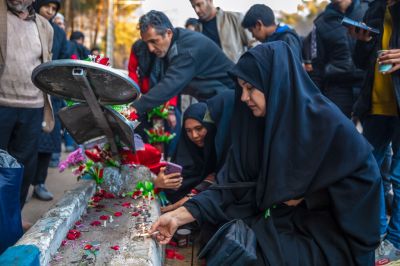Twin suicide bombings killed nearly 100 people in Kerman, Iran, last Wednesday at a procession commemorating the fourth anniversary of the death of Qassem Suleimani, the powerful commander of the paramilitary wing of the Islamic Revolutionary Guards Corps killed by a U.S. airstrike in Iraq. The next day, Islamic State’s Khorasan branch, based in Afghanistan, claimed credit for the deadliest terrorist attack since the founding of the Islamic Republic of Iran in 1979.
The timing, target, and execution of the attack all pointed to the Islamic State (despite Iranian officials pointing fingers at Israel and the United States for complicity), and a round-up of individuals in Iran with suspected terrorist ties reveals a concerted effort by the Islamic State to establish terrorist networks in the country. But more worrying, especially for European countries and other U.S. partners, is what this attack heralds from the Islamic State.
The Islamic State claimed the Kerman bombings as part of a new campaign dubbed, “Kill Them Wherever You Find Them,” launched in support of Palestinian Muslims. Within a 24-hour period, the Islamic State had claimed more than 30 different operations globally—from the Middle East to Africa to the Philippines—as part of this campaign, reanimating a seemingly dormant network. Few of the arguments made in the announcement itself are new. Pointing to the events in Gaza, the Islamic State called for supporters to target “Jews, Christians, and their allies” in the United States, Europe, and elsewhere.
One of the key distinctions between the Islamic State and other major jihadist groups is its focus on Iran. Unlike al-Qaeda, the Islamic State has actively targeted Iran and Shiites worldwide as perfidious enemies of Islam and ruthlessly condemned Sunni collaborators such as Hamas and Palestinian Islamic Jihad. This announcement was no different, emphasizing again the danger of the Shiites and their threat to Sunni Muslims. No doubt, the Kerman bombings were aimed in part at driving a wedge of suspicion between Shiite Iran and the Sunni jihadists it backs. As it has previously, the Islamic State is seeking to exploit regional tensions and moments of instability to create opportunities to advance its own cause, still pursuing reestablishing the Caliphate.
These bombings are simply another notch in the belt of Islamic State-Khorasan (IS-K). What senior U.S. officials warned of in the aftermath of the catastrophic withdrawal from Afghanistan—IS-K’s development of external attack capabilities to match its intent—has sadly been realized. And while the Kerman bombings are shocking given the terrorist outfit’s penetration of the tightly controlled Iranian society, they are part of a concerning trend. The group now threatens states neighboring Afghanistan and has extended its reach to include Bangladesh, India, the Maldives, Myanmar, and Sri Lanka. Reports from Kyrgyzstan of a foiled terror attack in late December reveal the outward progression of the Islamic State’s threat from Afghanistan.
Western states, particularly European ones, have felt much-needed relief from the Islamic State terror threat in recent years, especially after the collapse of the founding group in Iraq and Syria. But that lull in activity seems to be ending. Most concerning is how IS-K has transformed into its primary operational node using tradecraft developed to support terrorism attacks as far afield as Europe. Like al-Qaeda, which experienced significant counterterrorism pressure in Afghanistan and focused instead on developing a threat node based in Yemen, the Islamic State has adapted. The difference is that the Islamic State seems to be mastering a remote management of its cells, including online recruitment, guidance, and training. It’s not clear yet from Iranian statements regarding the detained individuals whether the network behind the Kerman bombings was built remotely or not.
In the past few weeks, European security services have detained multiple individuals suspected of being part of an Islamic State attack network. The suspects have alleged ties to IS-K and may have sought to strike gatherings on Christmas or New Year’s in places like Cologne, Germany; Vienna, Austria; or Madrid, Spain. Over the summer, a joint Belgian, Dutch, and German anti-terrorist operation rolled up a network of individuals with ties to the Islamic State–Khorasan. Multiple European countries have raised their national terrorism threat alerts over this growing threat.
That the Islamic State has not been successful in re-terrorizing Europe is not for lack of effort—but is a testament to counterterrorism professionals’ ongoing vigilance against the threat.IS-K’s rising transnational capabilities strike at a volatile time. The events in Gaza have clearly motivated individuals to take up violent jihad, galvanizing the movement. The Islamic State’s signature ability to identify, recruit, and activate would-be terrorists—essentially finding the lone operatives who need only to be told where, when, and how to attack—may prove especially dangerous in this reenergized global threat environment. Though IS-K activity has continued to trend downward inside of Afghanistan, its projection outward is on the rise. That’s a trend that should worry Washington and other European capitals.






Please note that we at The Dispatch hold ourselves, our work, and our commenters to a higher standard than other places on the internet. We welcome comments that foster genuine debate or discussion—including comments critical of us or our work—but responses that include ad hominem attacks on fellow Dispatch members or are intended to stoke fear and anger may be moderated.
With your membership, you only have the ability to comment on The Morning Dispatch articles. Consider upgrading to join the conversation everywhere.